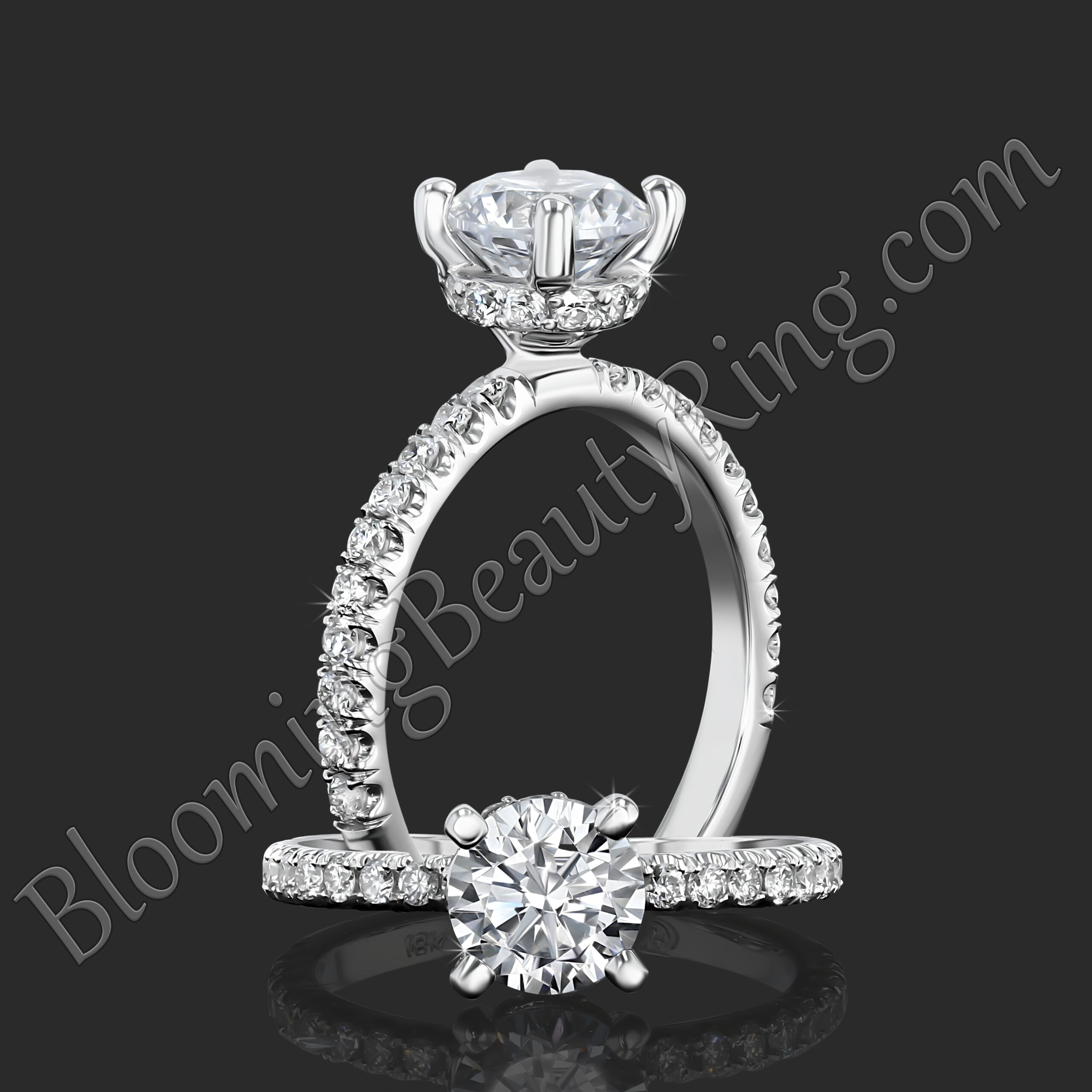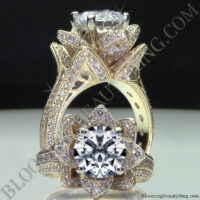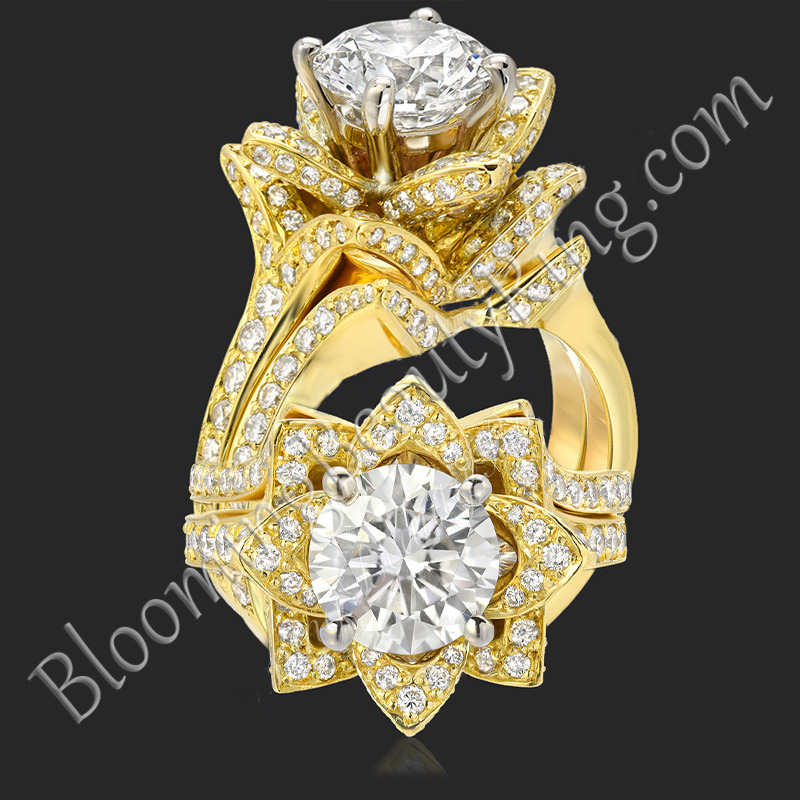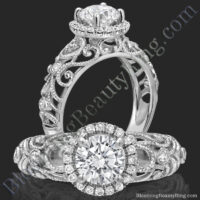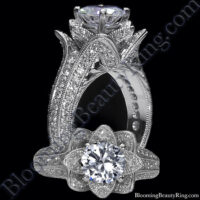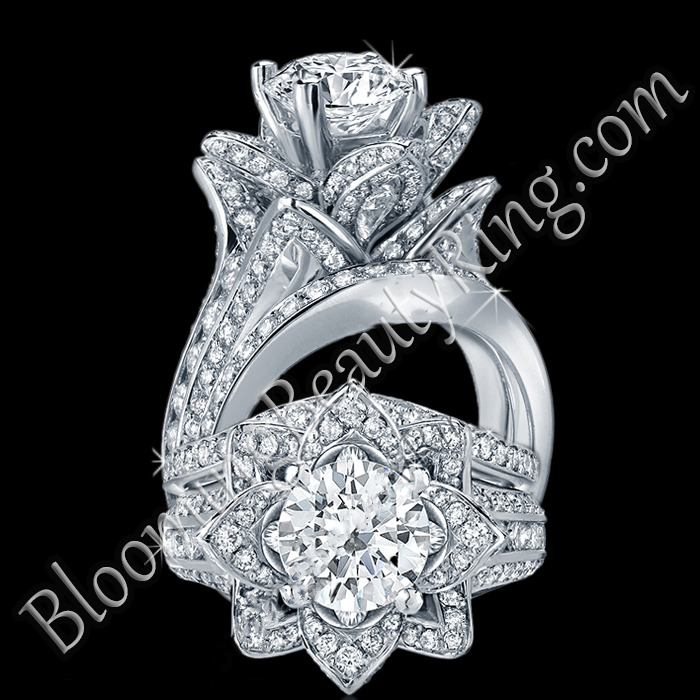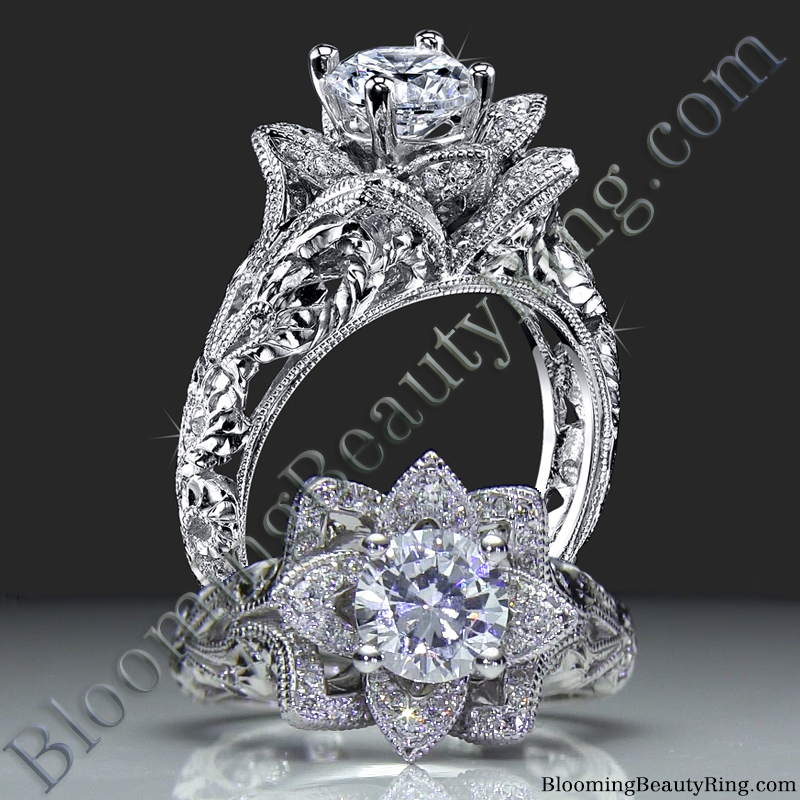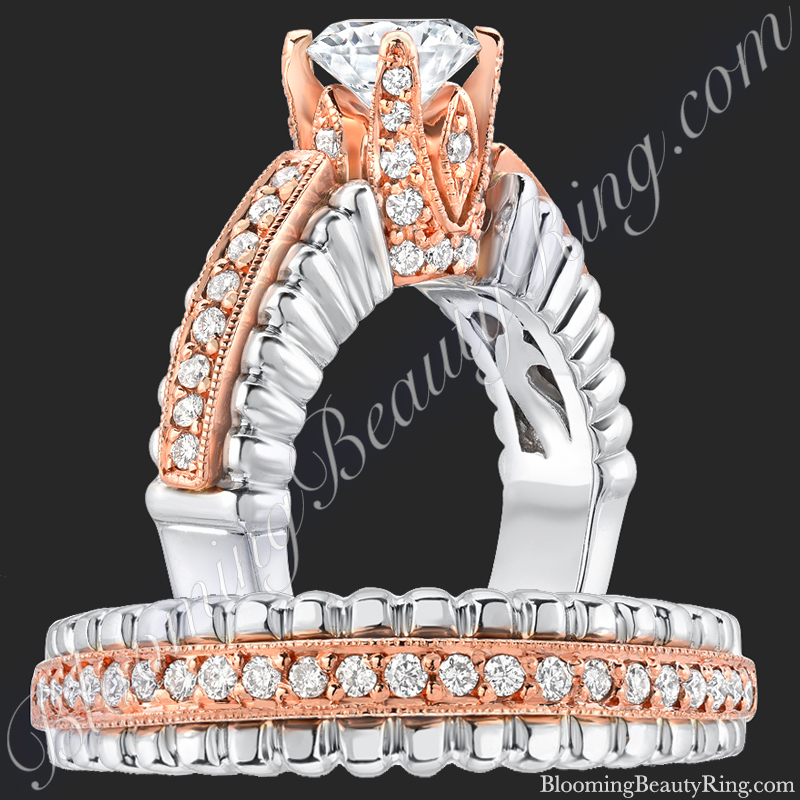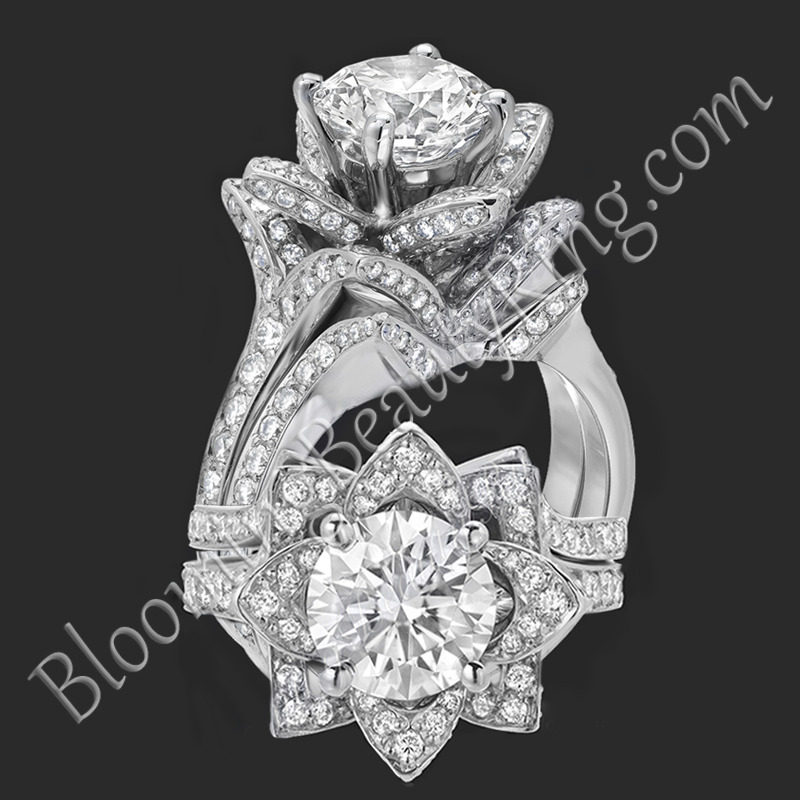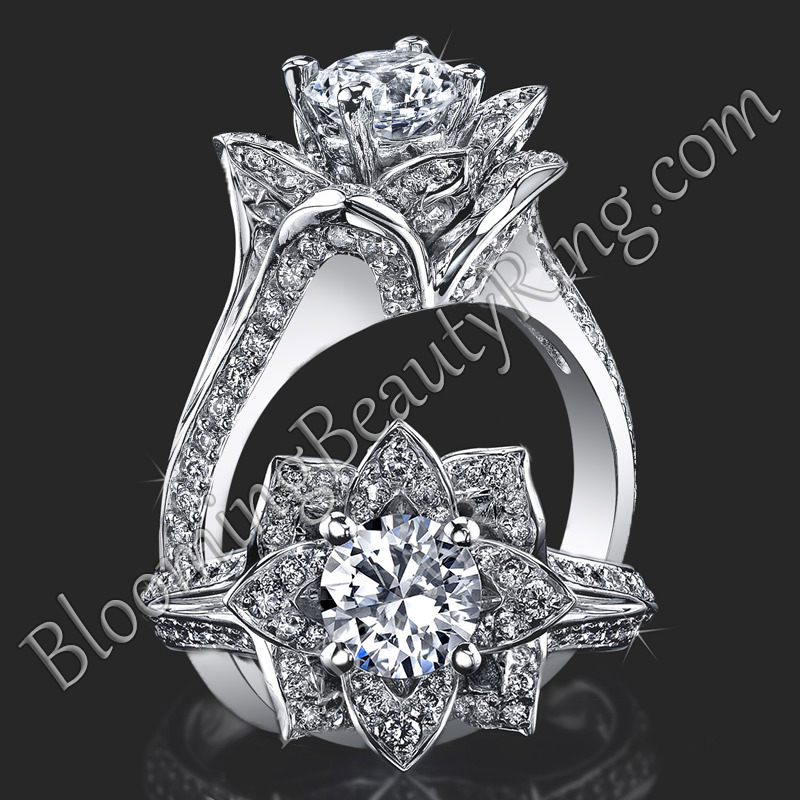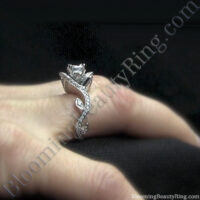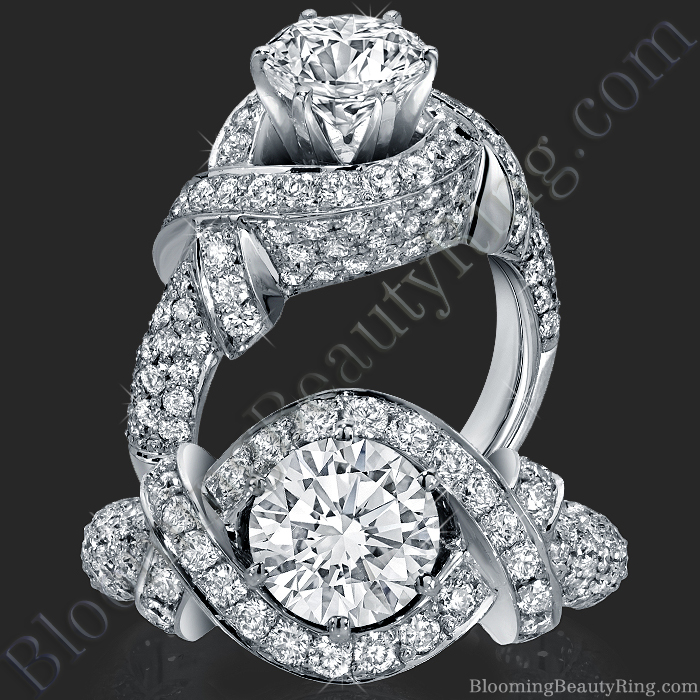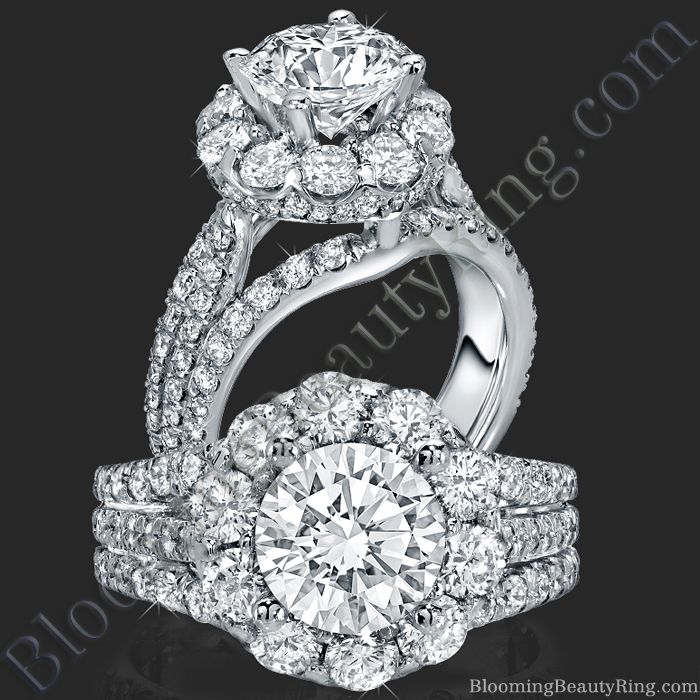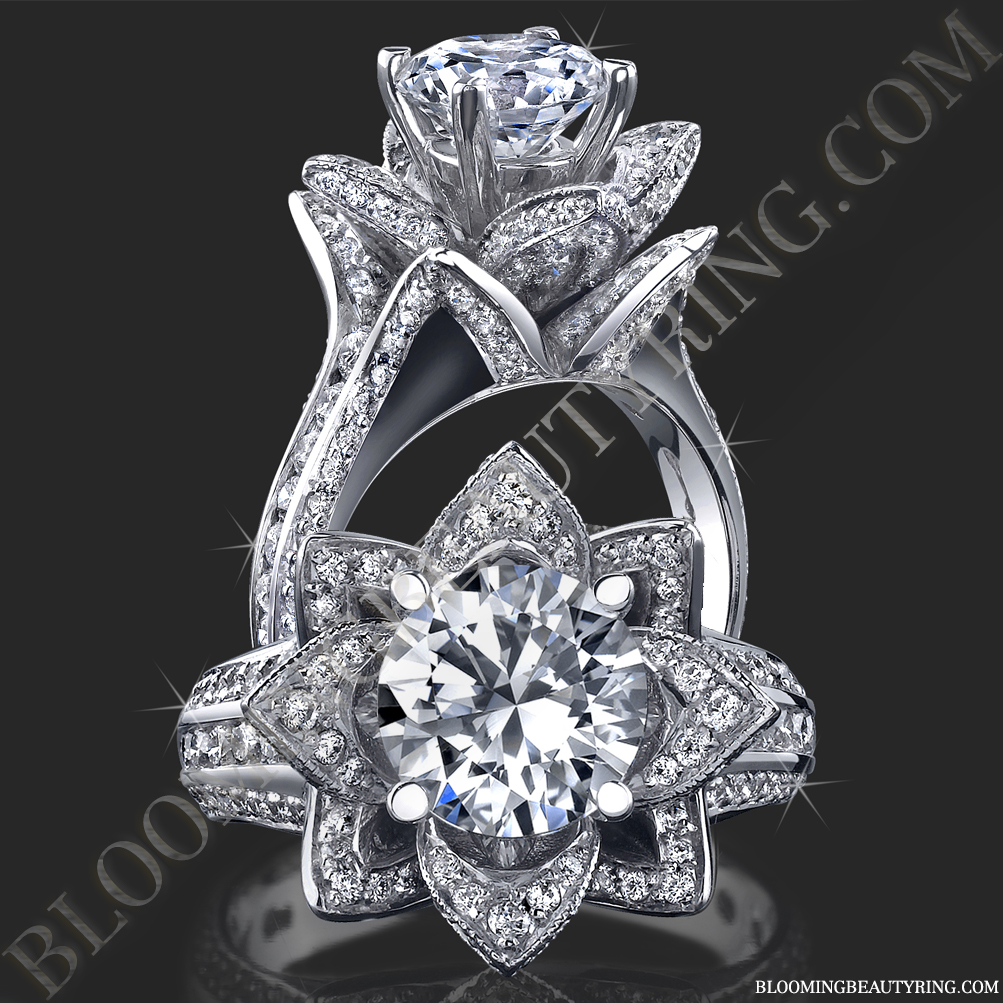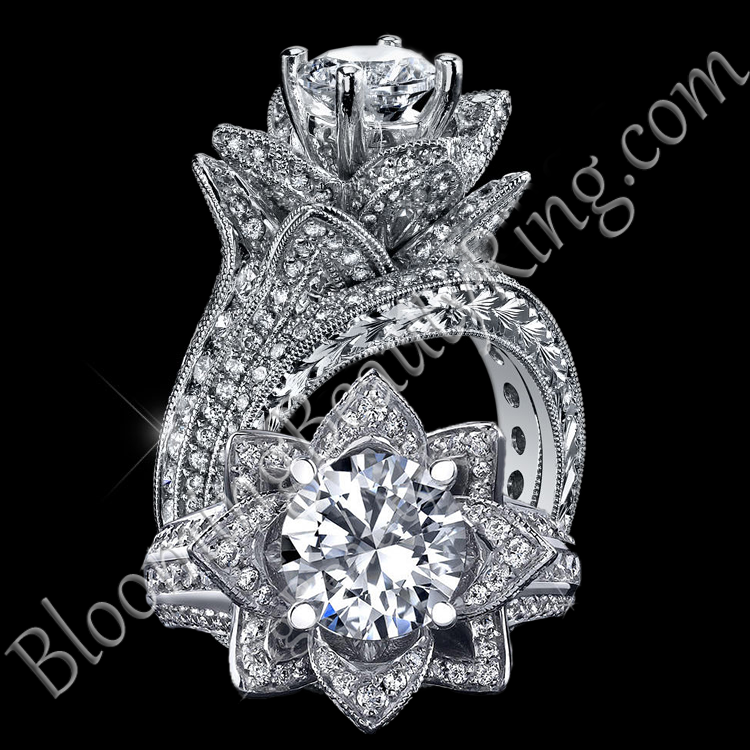~ Diamond Cuts Explained ~
Many customers begin with the notion that they want the biggest diamond possible. It's important to remember when shopping for a diamond that, “Bigger Is Not Always Better”.
In this article we are going to talk about diamond cuts. It seems that this topic can be pretty confusing to many people looking to buy a new diamond. The most common reason for this, is because diamond shape is often confused with diamond cut. Frankly it’s not surprising that people get a little confused at times, especially when they hear diamond professionals referring to diamond shapes as if they were a type of cut.
Common examples that we often hear are Princess cut diamond, Radiant cut diamond, Emerald cut diamond, Asscher cut diamond, and so on. The proper terminology that should be used is Princess Shape diamond, Radiant Shape Diamond, Emerald shape diamond, Asscher shape diamond.…you get the point.
Terms Used to Describe Diamonds:
Facets make up the surfaces of a diamond. When light enters in to a diamond, these facets act like tiny light bouncing mirrors that reflect light. Light that is reflected from properly cut and polished facets, create the sparkle, fire, scintillation and brilliance of a diamond. Where sparkle doesn’t really need an introduction, here’s a quick look at what the others mean.
-
Brilliance (Brilliant)
- A term used to describe the total amount of light that is reflected by a diamond. When light hits the surface of a diamond, some light enters the diamond and some is reflected back. The most immediate light reflected back is returned by the crown’s angle facets.
-
Scintillation (Sparkle)
- A term used to describe the sparkles, or flashes of light, which are produced when a diamond is moved underneath a light source. The light that isn’t reflected back enters the diamond and reflects from facet-to-facet, toward the center of the diamond. This light, which bounces off the facets of the diamond, is the quality described as scintillation.
-
Fire
- A term used to describe the dispersion of light into different colors of light. Once the light is bounced off the inside walls towards the center of the diamond, it then shoots back up through the top of the diamond. Because the light is slightly bent by the diamond, a color spectrum is visible when light exits the top of the diamond.
Quick Diamond Cut Facts:
-
Diamonds are priced “Per Carat Weight”
- This is referred to as a diamond’s Price Per Carat (PCP). You may also hear it referred to as “Cost Per Carat”. If all other factors were the same when comparing 2 diamonds, a better cut diamond would cost more per carat than it’s poorly cut counterpart.
-
A Diamond’s Polish
- Along with a Diamond’s Proportions and Symmetry ratings, a Diamond’s Polish rating is also considered important and is part of a Diamond’s Cut Grade. Polish is included on all reputable Diamond Grading certificates such as GIA, EGL and AGSL. A Poorly Polished diamond can have a negative impact on the diamond’s brilliance.
-
A diamond with an excellent or very good cut grade, does not guarantee a beautiful diamond.
- You still have to consider all of the other diamond grading factors such as fluorescence, clarity, color, Polish, culet etc. Buying a diamond on a budget is like performing a balancing act. You have to consider all of the desirable factors that you want in a diamond, and then balance them against your budget. Only you can determine whether a better color grade, better clarity grade, bigger carat weight, or better cut, is the most important factor for your budget.
-
You don’t have to buy a diamond that has an Excellent cut grade, in order for it to still be beautiful.
- Since GIA and AGSL cut grading are very stringent, even a diamond with a “Very Good” GIA or AGSL cut grade, can be very impressive.
Quick Look at Common Cut Grades
EX = Excellent
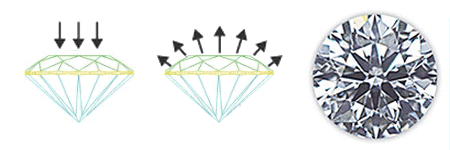
When light shines in the diamond and has no place to go, but back up through the top, it gives the best possible brilliance and fire. Excellent cut diamonds have the ability to make all colors below D appear whiter. Overall giving off a sparkle that can be seen across the room.
VG = Very Good
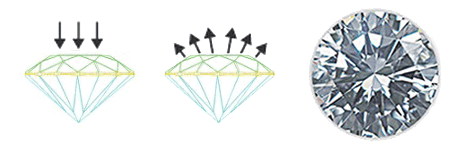
Very Good Cut Diamonds reflect most of the light that enters back out through the top still giving off a great deal of brilliance and fire. Choosing to trade a little proportion for more carat weight, in general, the very good cut diamond has many of the same parameters as the excellent cut. The best value for your money.
GD = Good

Good Cut Diamonds reflect app. 60 – 70% of the light that comes in back out the top. Every diamond can be an excellent cut diamond, however in the case of a good cut diamond the diamond cutter has chosen to sacrifice more ideal proportions for a larger carat weight. With a good color (G or above), and a nice clarity (SI1 and higher), these diamonds offer excellent value to anyone working within a budget.
FR = Fair
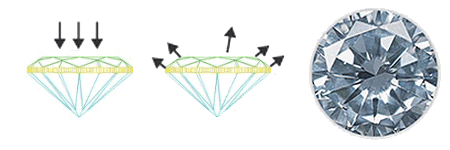
A Fair Cut Diamond will only reflect a moderate amount of light back out the top. Losing a fair share of light out the sides. Typically these are cut this way to maximize the most carat weight possible while still giving off some sparkle. Typically, you’ll find that the top of this diamond will carry a more darker hue than the Good, Very Good and Excellent cut diamonds.
PR = Poor
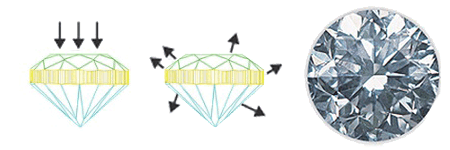
A Poorly Cut Diamond is all about the carat weight. Any brilliance or fire you would want reflecting back out the top will, in most cases, be reflected out the sides & bottom of the diamond. The top of a poorly cut diamond will often appear dull grey and lifeless to the eye.

Diamond Cut Matters
The first thing to mention about diamond cuts, is that cut matters a lot! At least if you want your diamond to sparkle. (Who doesn’t want to buy the most sparkly diamond possible?) Often times people shopping for diamonds, tend to focus on only 3 of the 4 C’s (Carat, Color, Clarity) and often forget about the “4th C”, cut grade. A Diamond’s cut grade refers to how well a diamond is cut, or proportioned. It also refers to a diamond’s symmetry, or how symmetrical it’s parts are. Proportions and symmetry play an important role in allowing a diamond to reflect light properly. If the proportions, symmetry and polish are perfect, the diamond will show an excellent ability to sparkle, and likely be issued an “Excellent Cut Grade”
Learn The Parts Of A Diamond
In order to learn about diamond cuts, first learn about the different parts of a diamond.
#1) Table: The table is the largest facet of a diamond and is located on the top of the diamond. (Yes, it is considered a facet) It resembles a flat “Table” and can vary in size, in relation to the size of the diamond. Many diamond professionals will state that an excellent cut round diamond, should have a Table diameter that measures 60% of the Girdle diameter. This is called the 60-60 rule. However others will state that the Table diameter percentage should be between 53% to 60%. My personal opinion is to stay closer to 60%. This is one area of Diamond Cut that opinions do vary.
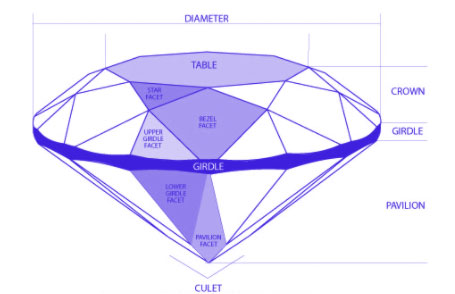
#2) Crown: The crown is made up of several facets and is the top, angled portion of the diamond. It is the section located below the table and above the girdle. The crown facets of a typical Round Brilliant Diamond Cut consist of 8 Star Facets, 8 Kite Facets, and 16 Upper Girdle Facets.
#3) Girdle: The Girdle forms the outer most edge of a diamond and it’s where the crown (top portion) and pavilion (bottom portion) of the diamond meet. It’s kind of like the “Equator” of the diamond. Some Diamonds have smooth Girdles and others have “faceted girdles”. Also, the Girdle of a diamond can vary in thickness. A Girdle that varies in thickness too much can be a sign of a poorly cut diamond. For example, if a Girdle varies from Extremely Thin to Extremely Thick, that is probably not a good sign. You should also consider staying away from a diamond with an extremely thin Girdle as it may be prone to chipping.
#4) Pavilion: The Pavilion is the lower, angled portion of the diamond. (the bottom half of the diamond) The pavilion also is made up of facets. These facets consist of 16 lower Girdle Facets and 8 Pavilion Facets.
#5) Culet: The culet (not cutlet) is the tiny facet at the very bottom point of a gemstone. If a diamond is cut perfectly, there may be no culet because the Pavilion facets will align perfectly to form a point. If a diamond is cut poorly, a culet will be present and can vary in size. Generally speaking, a culet is not desirable since it can create a dark shadow that is visible when looking through the top (table facet) of the diamond. The bigger the culet, the bigger the shadow. If a culet is present, it may be polished to form an additional facet. This means that a round diamond can have 58 facets, instead of 57.

The Girdle and Diamond Cuts
The Girdle diameter also plays an important role in calculating the depth percentage of a Gemstone. In order to calculate the Depth percentage, Gemologists will measure the total depth of the stone in millimeters (From the Table Facet to the Culet) and divide that measurement by the average Girdle diameter.A depth percentage of 60% is desirable for an excellent cut grade. My personal opinion is to stay within 59% to 61% depth.
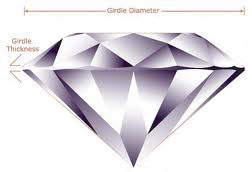
Depths lower than 59% are shallow cut diamonds and may appear larger than they should for their respective carat weight. Depth percentages larger than 61% will be Deep cut diamonds and appear smaller than they should for their respective carat weight. Although you may be tempted to buy a shallow cut diamond so that it appears larger than it should, just remember that you may lose some of the Sparkle Factor!
A look into how Depth, Girdle and Polish of a diamond plays a major role.
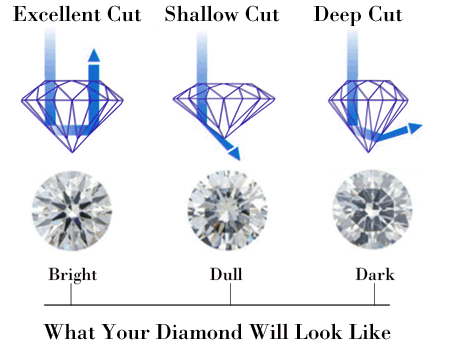
The side example gives you a great idea of why you can't just look at the carat weight when you purchase a diamond. You have to look at how well the diamond's cut is graded. And part of the cut grading has to do with the girdle and polish of your diamond.
I like to look at the Girdle and the Polish together, as they are what I call the reflective surfaces. Here's a good way to look at this.
The Girdle is the basically the middle of the diamond. It separates the crown and table from the pavilion and culet. All light has to pass through the Girdle, and then bounce back up again. So it stands to reason you don't want such a thick girdle otherwise the light will have a harder time getting through, and be more apt to reflect the light in abnormal ways.
Polish and Diamond Cut
Polish directly effect Cut. The polish is basically how clean the diamond surface is after it's been cut. The microscopic ridges in the diamond play another important part of reflectivity. Lets say you had a piece of glass and you scratch the surface of the glass, as you can image when light hits the glass and the scratch it will reflect oddly. So by keeping your Girdle between Thin and Slightly Thick you allow the most light to get through without any issues. Same with the polish of the diamond. All diamonds will have a polish grading. Try to keep it Very Good to Excellent.
Quick Look At GIA Girdle Measurements:
ETN = Extremely Thin | VTN = Very Thin

An Extremely Thin or Very Thin Girdle has no problem allowing light to pass through it, the problem lies in the actual thickness of it. The thickness is so thin that these grades become very susceptible to breaking or cracking. You’ll notice that if a diamond has an extremely thin girdle it’s actually penalized 4 points, if it’s a very thin girdle the cut will get penalized 1 point. You’ll want to avoid these, as accidentally hitting your ring up against a wall could chip your diamond.
THN = Thin | MED = Medium | STK = Slightly Thick

Thin, Medium and Slightly Thick Girdles are the preferred thickness and/or average. They have the best of both worlds. They are all thin enough to allow light in without a problem, and they are thick enough to withstand normal wear and tear you’ll put your diamond through. If your girdle has the THN, MED, or STK grades the cut will not be penalized. You should do your best to stay within these ranges.
THK = Thick | VTK = Very Thick | ETK = Extremely Thick
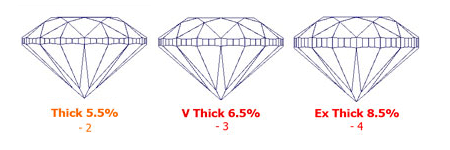
Problem with a thick, very thick and extremely thick girdle is two fold. First the girdles end up holding a lot of weight. Making your ,say, 1ct. diamond actually appear smaller than it should because the diamond weight is sitting in the girdle doing absolutely no good to the overall look/beauty of the diamond. Second is the greater the thickness the more light it can actually block and distort. Which is why these girdle grades can really make your cut grade take a beating.

Diamond Cut Grading Of GIA, EGL and AGSL
The next thing to mention about “Diamond Cuts” is that different diamond grading organizations will use different terms to describe them. And to make matters even more confusing, some retail jewelers will sell diamonds using their own names for cut grades. These companies want to give the perception that these diamonds are “The Best Of The Best” and you should pay more for them. (A common trick among many jewelers)
If you are willing to pay Top Dollar for these diamonds, by all means go ahead. However if you would like to save some money and still get a beautiful diamond, just do your homework and pick out the winner yourself. Remember, if you are buying a diamond from a reputable jeweler you will have plenty of time to return the diamond if it doesn’t meet your expectations, as most offer 30-60 day money back guarantees.
Types Of Diamond Cuts
There are basically three types of diamond cuts. We referenced them above, but just in case it wasn't clear we wanted to hit on this subject again.
Shallow Diamond Cut
Shallow cut diamonds appear bigger than they really are. Most of the weight of the diamond is sitting in the crown and table of the diamond. Which is say the top of the gem. The problem with this type of diamond cut is once the light enters the top of the diamond it will immediately leak about half of the light right back out the sides or bottom as the facets (basically the light reflectors of diamonds) are out of position for optimal brilliance. The end result; the diamond will end up with a cut grade of fair to poor and will appear dull.
Deep Diamond Cut
Deep cut diamonds appear smaller than they really are. Most of the weight of the diamond is sitting in the girdle and / or pavilion of the diamond. Which is say the bottom of the gem. The problem with this type of diamond cut is once the light enters the top of the diamond it will immediately leak majority of the light directly out the lower bottom facets. The end results won't appear as dull, as you need at least half the light coming into the diamond to come back up to achieve dull. No, the diamond will actually appear dark, as most of the light will never come back up, but pass through it like it's not even there.
Excellent Diamond Cut
Excellent cut diamonds appear the most brilliant, as they actually are. The weight of the diamond is proportional. That is to say that the top portion and bottom portion of the gem are very close to the same weight. With this even spread of weight the facets can be aligned (cut) to perfectly reflect light coming in right back up the top of the diamond giving you the sparkle and fire you want to see. Finding an excellent cut to very good cut grade diamond is more important than any other aspect of the diamond grading process.
All diamond certifications should come with a cut grade. Pay attention to it. Also different grading labs grade different. Take a look at our cushion cut diamonds page. There will see examples and guidelines to follow to know for sure whether your diamond's cut is excellent, very good, good, fair, or poor. We will be adding charts like this for all diamond shapes to make sure you know exactly what you're buying. EGLUSA, as well, has provided some in-depth diamond cut charts on princess and round diamonds. Click here to take a look.
Predict The Cut Grade Of A Diamond (This Is Really Neat!)
A very handy free online service that you can take advantage of, is the GIA Facetware® Cut Estimator. You will have to register for a free account in order to use this free service. However if you have the necessary information about any diamond, you can predict how GIA would grade the cut of that diamond by using GIA's database of more than 38.5 million diamond proportion sets in order to estimate the cut grade for any standard round brilliant diamond in the GIA D-to-Z color range and Flawless-to-I3 clarity range.


